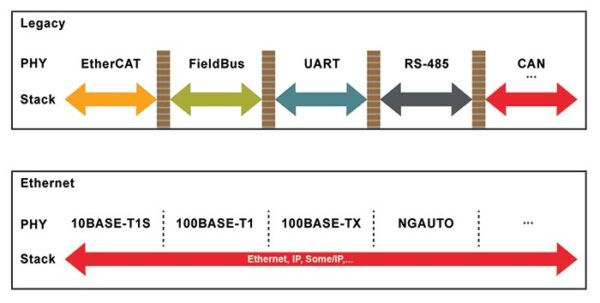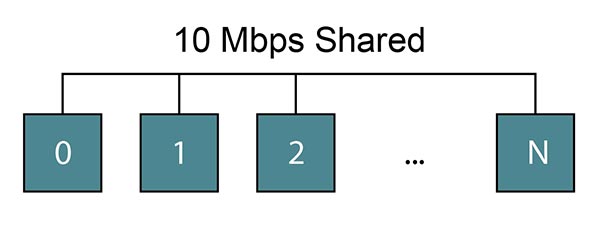Security and safety are essential to this technology and there are well defined frameworks for including them in Ethernet-based systems.
The service-oriented architecture of Ethernet helps manage complexity by encapsulating functions and data. Many systems can easily talk to each other using a unified communication mechanism that is reusable and allows for easy movement of services to the appropriate location in the network.
In the past, many different technologies have been used to interconnect dissimilar devices. In the industrial automation world there are various field busses, Ethercat, RS-485, UARTs, etc. In the automotive world, MOST, CAN, LIN and other networks are used, requiring complex gateway devices to communicate between domains. In the computer server market we see I2C, GPIO, SPI and even CAN, from the automotive world, used to manage various subsystems.
Each of these uses its own hardware interface and implements different software stacks. EMC behavior varies. An all-Ethernet architecture offers many advantages in that the same protocol is used independent of the physical layer. An Ethernet frame looks the same whether transmitted at 10 Mbit/s or 10 Gbit/s.
When scaling the bandwidth for particular applications, no complex gateways are required. Oftentimes, a single switch can be outfitted with PHY chips that run at different speeds, and the frames can seamlessly move from one domain to another without any modification of the data.
Figure 1 illustrates the advantage of an Ethernet architecture:
A ubiquitous Ethernet architecture simplifies the design, configuration and control of many different applications, whether in the industrial, computer or automotive worlds. The same technical expertise can be used in different markets. The same mechanisms are used no matter how much data needs to be transferred, as the Ethernet frame is not modified for the different speed grades. There is a large ecosystem of hardware and software suppliers that specialize in all aspects of the Ethernet communication infrastructure.
The Ethernet world has already designed architectures to ensure the security and privacy of the information transported over Ethernet links. This security infrastructure is well understood.
10BASE-T1S – A new IEEE standard
The IEEE has developed a new variation of the Ethernet standard that offers a bandwidth of 10 Mbit/s over a single pair physical layer. The specification is referred to as IEEE Std 802.3cg-2019™. The details have been finalized and the specification should be published in early 2020. This specification expands the breadth of modern Ethernet physical layers at the low end of the bandwidth spectrum.
One of the variants specified under the IEEE standard is called 10BASE-T1S. S stands for short reach. A long reach variant, called 10BASE-T1L, is also defined for distances of up to 1 km. This article concentrates on 10BASE-T1S.
10BASE-T1S uses a multidrop topology where each node connects to a single cable. This eliminates the need for a switch and results in fewer cables. Each cable only uses one pair of wires, instead of the four pairs used in typical Ethernet cabling. The interconnection can even be implemented on a printed circuit board. The standard specifies that at least eight nodes can be connected, but many more are possible. It also specifies a bus length of 25m, with 10 cm stubs to each node. All the nodes share the 10 Mbit/s bandwidth.
Figure 2 shows the concept of sharing the bus:
The standard also specifies an arbitration scheme called Physical Layer Collision Avoidance (PLCA) that offers full utilization of the available bandwidth with reduced latency and high Quality of Service (QoS).
Microchip Technology has been a key contributor to the IEEE standards process and is ready to support it not only with semiconductor products but with application boards and the tools needed to simulate, implement and analyze a networking system.
Physical Layer Collision Avoidance (PLCA) Details
When PLCA is enabled, only the PHY device that owns the transmit opportunity is allowed to send data. The transmit opportunities are allocated in a round-robin manner. Each PHY can transmit during its transmit opportunity and can then send a frame of information. A new cycle is started when the master node sends a beacon.
Figure 3 illustrates the process.
In practice, it has been observed that round-trip delays between two nodes are less than half a millisecond, with almost the full 10 Mbit/s available when using the iperf3 tool that is used to measure maximum achievable bandwidth on IP networks.
Applications
10BASE-T1S technology is getting traction in building/industrial automation, automotive and computer applications.
In industrial applications, this interconnection scheme is being deployed in many applications to provide intra-system management and to connect many devices like fans, temperature sensors, voltage monitors, etc. Even simple devices, like switches, buttons, indicator lamps, etc., can be addressed using Ethernet schemes.
In cars, a variety of sensors require lower bandwidth and benefit from a network architecture. It makes subsystems easier to expand for different trim levels of the vehicle.
The computing world is seeing the need for 10BASE-T1S in intra-system management interfaces inside servers and switches, along applications for configuring and monitoring large servers. Similar to the industrial world, various devices like fans, temperature sensors and voltage monitors can be easily accessed using Ethernet.
While transmitting Power over Data Lines (PoDL) is not fully standardized yet, there are groups working on it. A new IEEE task force has been created to expand the 802.3cg specification, including adding PoDL. The 10BASE-T1S physical layer is AC-coupled so it lends itself to carrying power to remote devices.
Conclusion
10BASE-T1S enables the expansion of Ethernet technology to new applications with its key features:
- Multi-drop physical layer
- No collisions
- Efficient bandwidth utilization
- Deterministic and low latency
- Security mechanisms
A ubiquitous Ethernet architecture simplifies the design, configuration and control of many different applications, whether in the industrial, computer or automotive worlds.
10BASE-T1S components are becoming available in the marketplace, and new system designs are already underway to implement the new technology. The necessary tools to do this are already available. To learn more, visit www.microchip.com.

Author:
Henry Muyshondt
Senior Manager
Social Media:
Twitter: https://twitter.com/microchiptech
Facebook: https://www.facebook.com/microchiptechnology/
Microchip Technology | https://www.microchip.com





